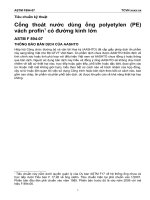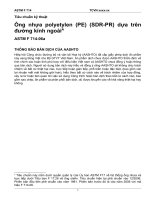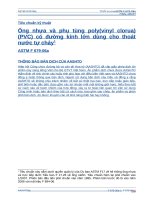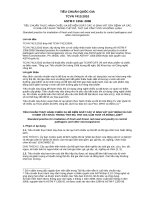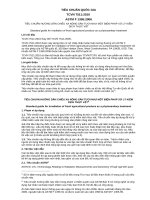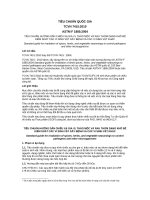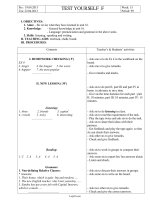Astm f 2709 15
Bạn đang xem bản rút gọn của tài liệu. Xem và tải ngay bản đầy đủ của tài liệu tại đây (83.01 KB, 4 trang )
Designation: F2709 − 15
Standard Test Method for
Determining a Measured Nameplate Recovery Rate of
Stationary Oil Skimmer Systems1
This standard is issued under the fixed designation F2709; the number immediately following the designation indicates the year of
original adoption or, in the case of revision, the year of last revision. A number in parentheses indicates the year of last reapproval. A
superscript epsilon (´) indicates an editorial change since the last revision or reapproval.
1.7 The values stated in SI units are to be regarded as
standard. No other units of measurement are included in this
standard.
1. Scope
1.1 This test method defines a method and measurement
criteria to quantify the performance of a stationary skimmer in
ideal conditions in support of a device’s nameplate recovery
rate (capacity). If a determination of a skimmer’s capabilities in
realistic conditions (that is, advancing or waves) is required,
testing should be performed according to Guide F631 or
equivalent.
1.8 This standard does not purport to address all of the
safety concerns, if any, associated with its use. It is the
responsibility of the user of this standard to establish appropriate safety and health practices and determine the applicability of regulatory limitations prior to use.
1.2 This test method includes the option of testing to
determine recovery efficiency.
2. Referenced Documents
2.1 ASTM Standards:2
D971 Test Method for Interfacial Tension of Oil Against
Water by the Ring Method
D1298 Test Method for Density, Relative Density, or API
Gravity of Crude Petroleum and Liquid Petroleum Products by Hydrometer Method
D2983 Test Method for Low-Temperature Viscosity of Lubricants Measured by Brookfield Viscometer
D4007 Test Method for Water and Sediment in Crude Oil by
the Centrifuge Method (Laboratory Procedure)
F631 Guide for Collecting Skimmer Performance Data in
Controlled Environments
1.3 This test method and parameters are intended to provide
ideal recovery conditions allowing the skimmer system to
operate and collect oil at its maximum possible recovery rate.
Given ideal conditions, inherent mechanical and physical
attributes of the system become the limiting factors.
1.4 This test method is intended to identify limitations of the
skimmer system, such as performance of the skimming
mechanism, the flow of oil within the skimmer and sump, the
pump characteristics, and typical discharge head conditions.
1.5 It is accepted that the measured nameplate recovery rate
as determined by this test method will not likely be achievable
under actual conditions of a spill. The measured nameplate
recovery rate should be used in conjunction with a de-rating
factor to account for such issues as changing encounter rate,
changes in other recovery conditions, changes in oil properties
and slick thickness, number of daylight hours, operator
downtime, less than ideal control of skimmer settings, and
inclement weather.
3. Terminology
3.1 Definitions:
3.1.1 fluid recovery rate—the volume of fluid recovered by
the device per unit of time (m3/h).
3.1.2 ideal conditions—operating conditions that result in
the maximum nameplate recovery rate of a skimming system
within the limitations of the test method.
1.6 This test method involves the use of specific test oils
that may be considered hazardous materials. It is the responsibility of the user of this test method to procure and abide by
necessary permits and regulations for the use and disposal of
test oil.
3.1.3 measured nameplate recovery rate—the maximum
rate at which the skimmer system can recover and process oil
under ideal conditions.
3.1.4 nameplate recovery rate—the maximum skimming
capacity of a device as stated by the manufacturer.
1
This test method is under the jurisdiction of ASTM Committee F20 on
Hazardous Substances and Oil Spill Response and is the direct responsibility of
Subcommittee F20.12 on Removal.
Current edition approved July 1, 2015. Published November 2015. Originally
approved in 2008. Last previous edition approved in 2008 as F2709–08. DOI:
10.1520/F2709-15.
2
For referenced ASTM standards, visit the ASTM website, www.astm.org, or
contact ASTM Customer Service at For Annual Book of ASTM
Standards volume information, refer to the standard’s Document Summary page on
the ASTM website.
Copyright © ASTM International, 100 Barr Harbor Drive, PO Box C700, West Conshohocken, PA 19428-2959. United States
1
F2709 − 15
4.10 For skimming systems that include various options for
the discharge pump, the test described in this test method may
be used to measure the performance of the skimming component of the system. Performance of the pumping component
can be measured independently using the same viscosity of oil
and the discharge head conditions noted in this test method.
The measured nameplate recovery rate of any specified skimming component and pump combination would be the lesser of
the skimming component and the pump.
3.1.5 oleophilic—oil skimmers that use collection surfaces
for recovery, for example, disc, brush, drum, belt, mop, and so
forth.
3.1.6 oil recovery rate—the volume of oil recovered by the
device per unit of time (m3/h).
3.1.7 recovery effıciency—the ratio, expressed as a
percentage, of the volume of oil recovered to the total volume
of fluids recovered.
3.1.8 skimmer system—a skimmer and ancillary equipment,
including power supply, hydraulic lines, discharge pump,
suction/discharge hoses, and control apparatus.
5. Test Facilities
5.1 The minimum lateral dimensions of the test tank shall be
three times the length and width of the skimmer device, that is,
if the skimmer has a dimension of 1 by 1 m, the test area shall
be 3 by 3 m. If the test is conducted without the presence of
water, the tank may be smaller; however, the skimmer must
float freely and be clear of the tank walls throughout the test
period. The tank depth shall accommodate the skimmer without grounding during the test.
4. Significance and Use
4.1 It has been industry practice to claim the capacity of a
skimmer based on the rate of the discharge pump (which are
typically rated using water as a test fluid) or other arbitrary
methods.
4.2 End users need a test methodology that evaluates
optimum performance data for planning and selection of
equipment.
5.2 Test oils shall be identified by industry-accepted name
and are recommended to fall within the five categories defined
in Guide F631.
4.3 This test method will assist producers and other stakeholders to verify and accurately report skimmer system performance.
5.3 It is recommended the skimmer system be tested in two
or more oil types for comparison purposes.
4.4 This test method is specifically designed to quantify two
key skimmer performance values, to reduce testing costs, and
to encourage industry wide performance standardization.
5.4 The oils used for testing will be characterized from
samples taken at the start of a test period or when oil is
replenished from a new source. A test oil log shall be generated
and will indicate test oil type, sample number, temperature, and
test date.
4.5 This test method establishes test conditions that will
result in a measured nameplate recovery rate and an indication
of the combination of test parameters (oil type, viscosity,
operating speed) that result in the highest average performance
for the tested skimmer system.
5.5 The following tests are to be conducted on oils: viscosity (Test Method D2983), bottom solids and water (Test
Method D4007), specific gravity (Test Method D1298),
surface, and interfacial tension (Test Method D971). Viscosity
may also be established using a published temperature/
viscosity chart for the test oil. Viscosity shall be reported for
the temperature at which the test is performed.
4.6 This test method will validate the performance of the
discharge pump in the skimmer system, under conditions that
are typical of a recovery operation. Specifically, this will
include a modest imposed head pressure composed of static
head and dynamic friction losses due to a specified length of
discharge hose.
5.6 Manual temperature measurements of the test oil (and
water, if applicable) will be taken in or near the skimmer sump
with an accuracy of 61°C. Note that if testing outdoors, solar
effects may significantly increase surface oil temperature. If
steam or heat is introduced into the skimmer system as part of
its design, additional measurements are to be taken before such
heating to gauge the properties of the oil accurately.
4.7 This test method encourages performance testing using
two or more oils for comparison purposes.
4.8 Tests shall be conducted under well-documented conditions and generate repeatable results. More detailed testing and
collection of skimmer performance is covered under existing
standards (for example, Guide F631).
5.7 Ambient air test temperature shall be recorded.
4.9 Testing (SL Ross 2007)3 has shown that, when water is
present, recovery performance in slick thicknesses ranging
from 50 mm to 75 mm results in values comparable to
significantly thicker slicks. This may not be the case with
high-rate skimmers in viscous oil, where the rate of oil
recovery exceeds the rate at which the slick will flow to the
skimmer mechanism.
5.8 Record water salinity if applicable.
5.9 The skimmer shall be tethered but must float freely for
the duration of the test.
5.10 Tanks are required for recovered product for subsequent volume measurements. The collection tanks shall be
elevated above the test oil surface to accommodate a required
static head on the skimmer system equal to 3.5 m of fluid.
Alternatively, a restriction may be imposed within the discharge hose to mimic the desired static and dynamic head at the
pump discharge at expected flow rates.
3
S. L. Ross Environmental Research Ltd., Skimmer Tests at the Ohmsett Facility
to Validate a Standard Test Protocol for Nameplate Recovery Rate, Minerals
Management Service, Herndon, VA, 2007 .
2
F2709 − 15
6.3.2 The test tank shall be preloaded with more than 75 mm
of test oil. Note to tester—additional oil may be added to the
preload to allow for adjustments, operational speed
measurements, and to achieve steady state recovery prior to the
collection period.
6.3.3 An accurate means of determining oil slick thickness
while the oil slick thickness is declining is required. Typical
means of accomplishing include manual soundings from tank
edge to oil surface or using a submerged translucent tube (site
glass) with an internal index.
6.3.4 The collection tank shall provide a means to decant
free water from the volume of recovered fluid.
5.11 For skimmers that do not include a discharge pump, the
recovery rate shall be measured as oil accumulates in the
skimmer’s sump.
5.12 When applicable, hydraulic pressure and flow measurements shall be made during the tests. Pressure and flow
values shall not exceed manufacturer recommendations.
6. Skimmer System Set-up
6.1 General:
6.1.1 The skimmer components shall be fully documented.
This shall include: dimensions, draft and freeboard, weight,
specifications of skimmer, hydraulic power unit, discharge
pump and hoses, and so forth. Components other than those
provided by the manufacturer and necessary to assemble a
functional skimmer system shall be reported.
6.1.2 The skimmer shall be deployed in the center of the test
area and tethered, but allowed to float freely.
6.1.3 If a discharge pump is offered by the manufacturer as
part of the system, the normal commercially offered pump shall
be used in this test. It may be installed in the skimmer head or
remotely but shall be configured as designed.
6.1.4 The manufacturer supplied power supply, hydraulic
lines, control apparatus, and accessories shall be used to
operate the skimmer.
6.1.5 Control lines, hydraulic lines, and discharge hoses
should not interfere with the normal operation of the skimmer.
Route hydraulic and discharge hoses to minimize effect on
skimmer freeboard.
6.1.6 The pump and power supply shall be operated within
its normal operating range or duty point for the system.
6.1.7 When applicable, the operational speed of the recovery device shall be recorded, that is, rotational speed of drum
or disc, or lineal speed of mop or brush. Various means may be
employed, for example, mechanical or manual counters, measuring hydraulic flow correlated to rotational speed and so
forth, but must be validated as part of each test series.
6.1.8 Test oil is transferred from supply to the test area for
establishing the initial preload volume slick thickness when
water is present.
6.1.9 The skimming system will be equipped with a discharge hose 15 m long and of the manufacturer intended
diameter. The discharge hose shall be routed to a collection
tank. The end of the discharge hose opening shall be elevated
3.5 m above the test oil surface unless the head is simulated as
described in 5.10.
7. Procedure
7.1 General:
7.1.1 This test method defines the procedure for quantifying
skimmer system recovery rate in a slick of all oil or oil with
water present while testing in ideal conditions. The presence of
water provides a means of determining corresponding recovery
efficiency.
7.1.2 The duration of the measurement period will depend
on the recovery rate of the skimmer. The measurement period
should be a minimum of 30 s. The skimmer system shall be at
a steady state operating condition before the collection period
begins and measurements are obtained.
7.2 Methodology:
7.2.1 Confirm preload volume of oil and, if water present,
slick thickness.
7.2.2 Measure the surface oil temperature and, if present,
water temperature below oil surface.
7.2.3 Start the power supplies for the skimmer and discharge pump.
7.2.4 If applicable, start data collection systems; (it is
beneficial to obtain hydraulic pressure and flow measurements,
supply tank volume, and so forth.)
7.2.5 Start the skimmer discharge pump and, if applicable,
recovery device simultaneously.
7.2.6 Recover fluid to a secondary tank until flow is
established and operational adjustments have been completed.
7.2.7 When the skimmer is operating to the satisfaction of
the skimmer operator and steady state recovery is established,
recovered fluid shall be diverted to the dedicated collection
tank. Simultaneously start the collection period timer.
7.2.8 Recover fluids until the appropriate collection time or
recovered fluid volume criteria are met.
7.2.9 When testing with a slick floating on water, the
starting thickness may range from 75 to 100 mm to allow for
startup and establishing a steady recovery rate. The measurement period shall start when the slick thickness is approximately 75 mm, shall be a minimum of 30 s after steady state
conditions are achieved, and shall end when the slick thickness
approaches 50 mm.
7.2.10 During the recovery period, confirm operational
parameters, that is, drum rotational speed, discharge pump
speed, and so forth.
7.2.11 Stop the skimmer and discharge pump or redirect
flow to the secondary collection tank. Simultaneously stop the
collection period timer.
6.2 Testing with Oil Only:
6.2.1 The volume of oil preloaded into the test tank shall be
sufficient for the skimmer to remain free-floating throughout
the test.
6.2.2 The collection tank shall be calibrated to accurately
quantify the volume of fluid collected. Measurement accuracy
shall be determined and documented.
6.3 Testing in Oil with Water Present:
6.3.1 The test tank shall be preloaded with fresh or salt
water to a sufficient depth for the skimmer to remain freefloating throughout the test.
3
F2709 − 15
7.2.12 Stop the data collection system.
7.2.13 Measure and record the total volume of fluid (oil or
oil and water) in the dedicated collection tank(s). Volume
typically is determined by sounding the tank and knowing
volume/depth the total volume of fluid calculated.
7.2.14 When testing with water, decant the free water from
the dedicated collection tank(s) Determine the volume of
remaining fluid. The remaining fluid may contain water due to
emulsification.
7.2.15 When testing with water take a representative sample
of fluid from the dedicated collection tank(s). Perform analysis
to determine water content (Test Method D4007). Mixing of
the recovered product will ensure a representative sample has
been obtained. Label sample with test number, tank designation (if applicable), date, and time.
7.2.16 If necessary, replenish the test area with the volume
of oil to provide the proper slick thickness for the next test.
7.2.17 The tests shall be repeated three times for any given
set of parameters. Test result values shall be considered valid if
no values deviate more than 20 % from the arithmetic mean.
NRR = measured nameplate recovery rate in lpm,
Voil = volume of oil recovered in litres, and
T
= elapsed time in minutes.
Measured nameplate recovery rate in barrels per hour (bbl/h)
is calculated as:
Bbl/h 5 lpm x 0.377
8.7 When tested with water present, the skimmer system
shall have a minimum recovery efficiency of 70 % (oil) or the
test run shall be recorded but shall not be valid for the
calculation of the measured nameplate recovery rate.
8.8 Calculate recovery efficiency (RE) as:
RE 5
volume of oil recovered
total volume of fluid
(3)
9. Report
9.1 Computer-gathered data files, manually recorded data,
analytical data, and photo and video documentation shall be
used to produce a final report.
8. Skimmer Performance Calculations
8.1 Skimmer performance is calculated from three measured quantities: the oil volume recovered by the skimmer
(Voil), the oil collection time (t), and volume of water recovered
by the skimmer if water is used. The primary performance
values sought during these tests are measured nameplate
recovery rate (NRR) and recovery efficiency (RE).
9.2 For the three qualifying tests, the skimmer oil recovery
rate, oil viscosity, oil and water temperature, oil slick thickness,
and speed of skimmer system pump, powerpack, and rotating
elements (including hydraulic flow rates where applicable)
should be recorded and included in the final report.
9.3 The final report shall include a full description of the
equipment tested and the test.
8.2 The total volume of fluid recovered by the skimmer is
calculated from volumetric calculations specific to the collection tank used.
9.4 A table of primary and secondary skimmer characteristics will be generated. This table will document the physical
parameters of the skimming system including but not limited to
skimmer dimensions, oleophilic surface area, power pack
capacity, discharge hose diameter, pump data, hose length, and
other details as appropriate.
8.3 The volume of oil recovered is calculated from the
volume of remaining fluid, determined after the free water has
been decanted and corrected for the percent water in oil.
8.4 The oil collection time is the elapsed time that the
skimming system is recovering oil at steady state conditions,
and the discharge directed to a specific collection tank.
9.5 The measured nameplate recovery rate shall be reported
as ____ bbl per hour for type ___ oil (I, II, III, IV, or V), with
an actual oil viscosity of ____ cP, the test performed according
to ASTM Test Method F2709. Specify whether the test was
performed on oil only or oil on water. Report the industry name
for the oil used in the tests.
8.5 The start and end time is measured with a calibrated
stopwatch by the test director.
8.6 The measured nameplate recovery rate for each performance test is calculated as follows:
NRR 5 V oil/T ; per oil type
(2)
Measured nameplate recovery rate shall be reported as a
single value (see 9.5) calculated as the arithmetic mean of
the (minimum) three tests performed.
(1)
10. Keywords
where:
10.1 nameplate; oil; recovery; skimmer
ASTM International takes no position respecting the validity of any patent rights asserted in connection with any item mentioned
in this standard. Users of this standard are expressly advised that determination of the validity of any such patent rights, and the risk
of infringement of such rights, are entirely their own responsibility.
This standard is subject to revision at any time by the responsible technical committee and must be reviewed every five years and
if not revised, either reapproved or withdrawn. Your comments are invited either for revision of this standard or for additional standards
and should be addressed to ASTM International Headquarters. Your comments will receive careful consideration at a meeting of the
responsible technical committee, which you may attend. If you feel that your comments have not received a fair hearing you should
make your views known to the ASTM Committee on Standards, at the address shown below.
This standard is copyrighted by ASTM International, 100 Barr Harbor Drive, PO Box C700, West Conshohocken, PA 19428-2959,
United States. Individual reprints (single or multiple copies) of this standard may be obtained by contacting ASTM at the above
address or at 610-832-9585 (phone), 610-832-9555 (fax), or (e-mail); or through the ASTM website
(www.astm.org). Permission rights to photocopy the standard may also be secured from the Copyright Clearance Center, 222
Rosewood Drive, Danvers, MA 01923, Tel: (978) 646-2600; />
4


